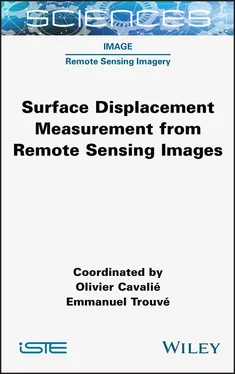1 ...6 7 8 10 11 12 ...16 Data access: During the missions, European Space Agency (ESA) products were not free of charge and RAW data were much cheaper. Furthermore, some technical teams preferred to do the radar synthesis themselves to ensure a better signal shape in the range spectrum. Nowadays, as indicated by the ESA (2019), the (A)SAR on-the-fly (OTF) data processing and dissemination service allows end-users to gain direct access to ESA’s complete high-resolution (A)SAR archive from the ERS-1, ERS-2 and Envisat missions. The service provides (A)SAR Level 1 high-resolution data, which are processed from Level 0 on user request by the system. Users can register themselves and immediately download Level 1 (A)SAR data products. The service is available via the ESA Online Dissemination Service at https://esar-ds.eo.esa.int/oads/access.
1.2.2. Canadian C-band satellites: Radarsat-1, Radarsat-2 and RCM
Radarsat-1 was the first imaging radar developed for the Canadian Space Agency (CSA). It was launched in December 1995 and ended its operations in April 2013. The satellite had noticeable activity over the Arctic areas for ice monitoring. In the late 1990s, it was the only civilian radar capable of imaging part of the Earth, while ERS could only operate in the visibility of ground receiving stations due to the lack of onboard recording. The satellite offered a variety of imaging modes, including the large swath in ScanSAR (510 km) and narrow ScanSAR (305 km), seven stripmaps (100 km) and three others with 150 km swath, ranging from 20 to 47°, as well as 15 fine modes at incidences above 37° (45 km). The radar operated only in single co-polarization HH. The satellite native design was right-looking imaging, but the CSA conducted a dedicated campaign over Antarctica with a 180° rotation of the spacecraft, making it left-looking, and the first radar mosaic of the continent could thus be produced. Interferometry was demonstrated during the mission, although there were some strong limitations with this spacecraft. Radargrammetry for DEM was also demonstrated, prior to the SRTM mission.
There were several limitations of the mission with regard to interferometry:
– the satellite was not yaw-steered, meaning the Doppler centroid had strong values, exceeding several PRFs, as well as strong variations in the year, and for interferometry, we should take care when combining pairs, the minimum and maximum of Doppler shift being around the solstices;
– the orbit-keeping was quite loose, and baselines reached several kilometers;
– orbital knowledge was a special issue in computing correct interferograms, and the use of fine orbit interpolators, such as Hermite polynomials, was a necessity.
The Radarsat-2 spacecraft was launched in December 2007 while Radarsat-1 was still operating. The spacecraft added significant improvements in many areas: right-and left-looking, quad polarization, low σ 0, ultrafine modes, ground track maintained within a 500 m wide range, yaw steering and onboard state recorders. Although on the same reference orbit as Radarsat-1, Radarsat-2 images were not pairable with Radarsat-1 for interferometry: the central frequency was shifted from 5.3 to 5.405 GHz and the Doppler centroid was not compatible, due to the difference in yaw steering. At the end of 2020, the spacecraft was still operating, making a transition to the next Canadian SAR mission.
The Radarsat Constellation Mission (RCM) aims to replace the Radarsat-2 mission, continuing the traditional Canadian C-band SAR imagery as well as adding automatic identification system (AIS) payloads to improve maritime surveillance. It is composed of three identical satellites that were launched together in June 2019 for an expected lifetime of seven years. The sun-synchronous constellation has a 18:00 ascending node and flies at an altitude range between 586 and 615 km. As the three satellites are equally spaced along the orbit, the repeat time is only four days, and the orbit is maintained within a 120 m radius orbital tube, which gives good advantages for several InSAR applications. Various schemes of polarization are implemented: single polarization, dual co-cross or compact polarimetry are available on all modes; dual HH–VV is available for specific modes, as well as a quad-polarization mode. Radar modes are numerous, from spotlight (1×3 m resolution, one look) to wide ScanSAR (100 m, eight looks)
Data access: Since April 2019, 36,000 images of archive data acquired by the Government of Canada all over the world have been freely available (see CSA 2019). Unfortunately, not all acquired data can be accessed at the time of editing (2021).
1.2.3. Japanese L-band satellites: JERS-1, ALOS and ALOS-2
The Japanese Earth Resources Satellite (JERS-1) was the first of a series of Japanese SAR sensors working in the L-band, followed later by the Advanced Land Observing Satellite (ALOS) and ALOS-2. All three projects were conducted under governmental institutions. Launched in February 1992, JERS-1 lost its onboard recording capacity in August 1997, which limited its use over direct receiving ground stations, and the spacecraft finally terminated its mission in October 1998. The SAR sensor operated at 1.275 GHz (wavelength of 23.5 cm), with a bandwidth of 15 MHz. Only co-polarization in HH was implemented. The nominal swath was a stripmap mode of 75 km, at a fixed look angle of 35°. Tracks were acquired regularly, minimizing the time between two consecutive swaths, which was a great advantage for large mosaics and radiometric stability. Interferometry showed great coherence for vegetated areas compared to C-band radar, as in ERS, with comparable resolution. As an optical system (OPS) was also used, the satellite was put on a sun-synchronous orbit with a descending node at 10:30 to 11:00.
ALOS was the second Japanese satellite and was able to deliver L-band SAR images through its PALSAR instrument operating at a 1,270 MHz central frequency. The launch took place in January 2006, and the local hour was set at 10:30 descending node, with an onboard optical sensor (PRISM, AVNIR-2). The bandwidth was increased to 28 MHz in single-polarization HH or VV and 14 MHz in dual-polarization HH+HV VV+VH or quad polarization with different fine beams, with 70 km and 40 km swath, respectively. The ScanSAR mode only worked in co-polarization HH or VV, with a 350 km swath sub-divided into five beams. The spacecraft stopped operating in May 2011.
In April 2014, ALOS-2 followed the ALOS program with an L-band radar payload, without the optical part later put on ALOS-3. Compared to ALOS, the ALOS-2 PALSAR instrument improved the resolution (tunable between 14 and 84 MHz), the revisit cycle (14 days instead of 46 for ALOS) and right and left imaging capacities and provided new modes, such as spotlight and ScanSAR with burst synchronization for ScanSAR interferometry.
Data access: We can note that the background mission of these satellites was orchestrated by a basic operational scenario, i.e. a long-term homogeneous and consistent programming of the whole Earth in different modes, with regular updates. It is possible to freely access JERS-1 and ALOS data through the ESA EO portal at https://earth.esa.int/web/guest/-/jers-1-sar-level-1-single-look-complex-imageand https://earth.esa.int/web/guest/-/alos-palsar-fbs-fbd-and-plr-products, respectively. The datasets contain all ESA acquisitions over the ADEN zone (Europe, Africa and the Middle East), plus some worldwide products received from JAXA.
The Shuttle Radar Topography Mission was aimed at computing a semi-global digital elevation model from the Earth. This was achieved in February 2000 on board the US space shuttle Endeavour carrying the SIR-C/X-SAR payload, which previously flew in 1994 in L-, C- and X-bands. This time, the payload was reconfigured as a single-pass interferometric mission with a fixed baseline as long as the 60 m mast that separated the dual antennas in two bands: the C-band instrument from the Jet Propulsion Laboratory (JPL) and the X-band instrument from the Italian Space Agency (ASI) and German Space Agency (DLR). For the C-band, swath reached 225 km thanks to a four-beam ScanSAR, and for the X-SAR instrument, there was a stripmap swath of 50 km. The mission duration was limited to 11 days: only the C-band swath could assure the semi-global DEM, while the X-band covered a subpart of it. Due to the 57° inclined orbit of the shuttle at an altitude of 223 km, the DEM covered only latitudes ranging from 56° south to 60° north.
Читать дальше












